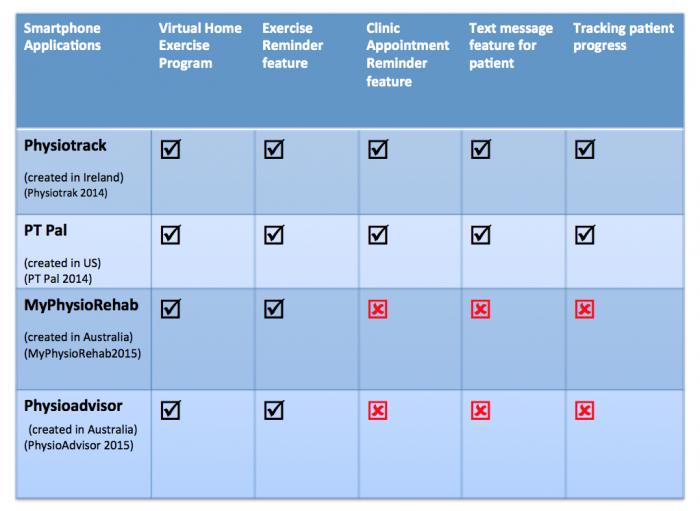Telerehabilitation and Smartphone Apps in Physiotherapy: Difference between revisions
| Line 21: | Line 21: | ||
===== Telerehabilitation ===== | ===== Telerehabilitation ===== | ||
===== Progression of technology ===== | ===== Progression of technology ===== | ||
Revision as of 23:32, 20 November 2015
Original Editor - Oriana Catenazzi, Alicia Rebellato, Hannah Meredith, Aaron Kirk, Martin Fitheridge, Marco Zavagni
Introduction to Telerehabilitation and smartphone physiotherapy applications
[edit | edit source]
add text here relating to introduction
Learning Outcomes
[edit | edit source]
add text here relating to the learning outcomes
Table of Contents [edit | edit source]
add text here relating to the table of contents
Overview of Telerehabilitation[edit | edit source]
add text here relating to diagnostic tests for the condition
Telerehabilitation[edit | edit source]
Progression of technology[edit | edit source]
Applications for specific conditions[edit | edit source]
Scotlands Telehealth and Telecare delivery plan[edit | edit source]
The patient perspective on telerehabilitation[edit | edit source]
Key points[edit | edit source]
Understanding the patient[edit | edit source]
Introduction[edit | edit source]
Transtheoretical model[edit | edit source]
Self-efficacy theory[edit | edit source]
Motivation[edit | edit source]
Self-determination theory[edit | edit source]
Goal setting[edit | edit source]
Clinical implications[edit | edit source]
Research[edit | edit source]
Current smartphone applications and modernization of physiotherapy
[edit | edit source]
Introduction
[edit | edit source]
Current physiotherapy applications[edit | edit source]
Further considerations: Improved communication [edit | edit source]
Facilitating patient-provider relationship[edit | edit source]
Utilising reminder services to enhance communication[edit | edit source]
Facilitating Knowledge and Education through Physiotherapist communication[edit | edit source]
Communicating the right exercise prescription[edit | edit source]
Further considerations: Facilitating behaviour change[edit | edit source]
Intrinsic and extrinsic motivation towards rehabilitation[edit | edit source]
Self-efficacy and goal setting[edit | edit source]
Cost effectiveness[edit | edit source]
Limitations
[edit | edit source]
add text here relating to the limitations
Conclusing Remarks [edit | edit source]
add text here relating to key evidence with regards to any of the above headings
CPD Test your knowledge [edit | edit source]
add appropriate resources here
References[edit | edit source]
References will automatically be added here, see adding references tutorial.







